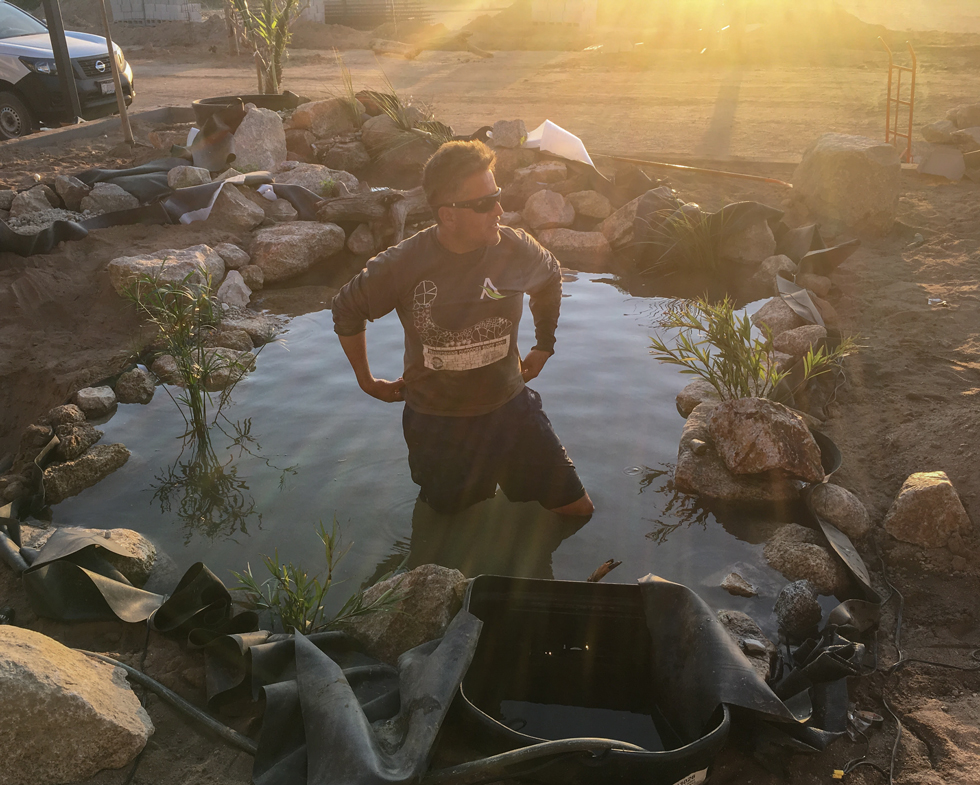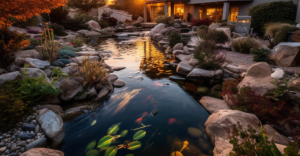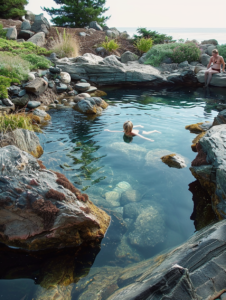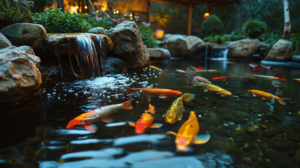A natural rec pond is like a regular pool but instead of using chemicals to keep the water clean, it relies on nature’s processes.
Here’s how it works:
Swimming Area: Just like a regular pool, there’s a place for swimming and having fun.
Plant Zone: Nearby, there’s a special area with plants like water lilies. These plants help clean the water by taking out bad stuff like dirt and algae.
Biological Filtration: Good bacteria, which are like tiny helpers, also live in the water. They eat up things that could make the water not so nice, keeping it clear and healthy.
Separation of Zones: The pool is divided into two parts—the swimming area and the plant area. Water moves between them, so the plants and filters can keep doing their job.
No Chemicals: Unlike regular pools that use chemicals like chlorine, a natural pool doesn’t need them. It keeps the water clean using the power of plants and helpful bacteria.
Aesthetics: Natural pools are designed to look pretty, with plants, rocks, and other natural things. They fit in with the environment and make the pool area more beautiful.
Optional Fish Inclusion: Some people choose to add fish like koi or goldfish to their natural pool. These fish can help by eating tiny creatures and their waste acts as food for the plants. But having fish is a choice; you don’t have to have them.
So, an Aquascape Recreations Pond is a cool way to enjoy a swim while letting nature take care of keeping the water clean and healthy!
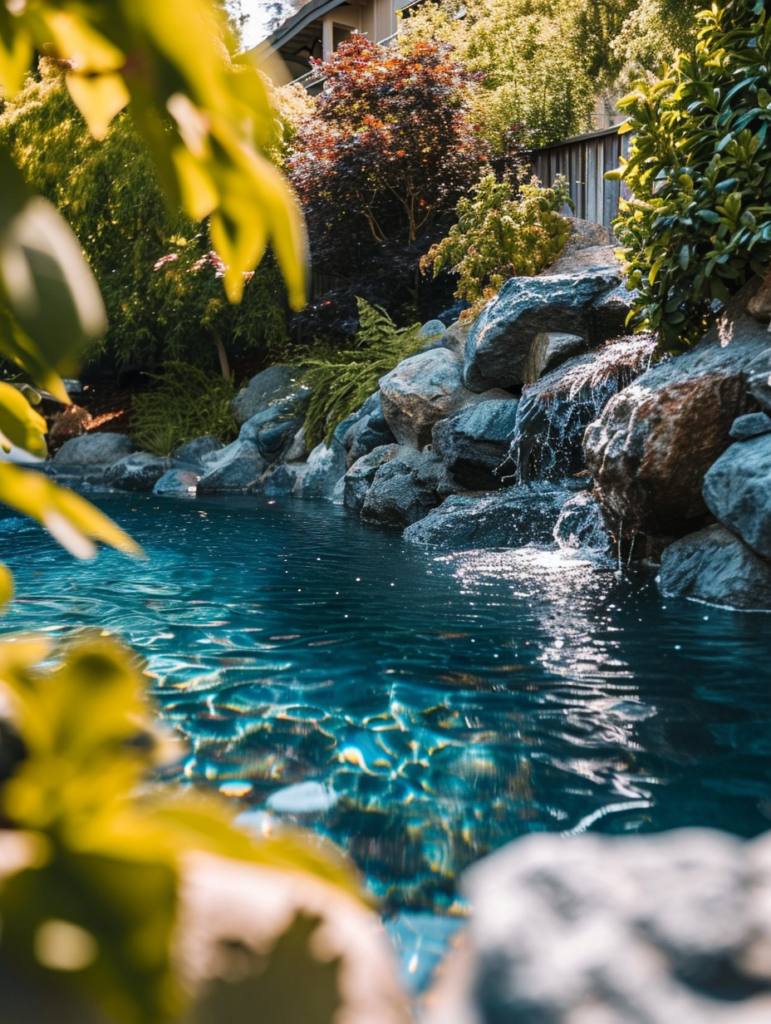
Some of the benefits:
- Chemical-Free and Gentle on Skin: One of the significant advantages of natural swimming pools is that they do not rely on harsh chemicals like chlorine. This makes the water gentler on the skin, hair, and eyes, reducing the risk of irritation and allergic reactions often associated with traditional pools.
- Ecologically Balanced: By incorporating plants, beneficial bacteria, and, optionally, fish, natural swimming pools create a self-sustaining ecosystem. This balanced environment promotes water purification, reduces the need for external interventions, and contributes to a healthier aquatic habitat.
- Aesthetic Appeal: Natural swimming pools are designed to blend seamlessly with the natural surroundings. The presence of aquatic plants, rocks, and other natural elements enhances the visual appeal of the pool area, creating a more aesthetically pleasing and harmonious space.
- Biodiversity: The inclusion of plants and, optionally, fish, fosters biodiversity within the pool ecosystem. This diversity can attract beneficial insects, birds, and other wildlife, contributing to a more vibrant and dynamic environment.
- Environmentally Friendly: Traditional pools often require energy-intensive systems for water circulation and filtration. Natural swimming pools, on the other hand, rely on biological processes and natural elements, resulting in a more eco-friendly and sustainable approach to water management.
- Low Operating Costs: While the initial construction of a natural swimming pool may require an investment, the ongoing operating costs can be lower than those of conventional pools. The reduced need for chemicals and energy-efficient filtration contribute to cost savings over time.
- Connection to Nature: Swimming in a natural pool provides a unique and immersive experience, allowing individuals to connect with nature. The sights and sounds of plants, fish, and the overall natural setting create a more tranquil and enjoyable swimming environment.
- Year-Round Use: Natural swimming pools can be designed to function year-round. In colder seasons, the regeneration zone can continue to operate, providing an attractive feature even when the swimming area is not in use.
In summary, a recreational pond offers a host of benefits, including a chemical-free and skin-friendly environment, ecological balance, aesthetic appeal, biodiversity support, environmental friendliness, cost-effectiveness, and a unique connection to nature. These factors make them a compelling choice for individuals seeking a more sustainable and holistic approach to pool ownership.
Things to consider:
- Algae Growth: Recreational ponds may experience algae growth despite the presence of aquatic plants and biological filtration, affecting water clarity.
- Temperature Considerations: Recreational ponds may take longer to warm up in cooler climates due to their reliance on natural processes, influencing the swimming season.
- Design Complexity: Designing and constructing a recreational pond requires careful planning to ensure proper water circulation, balance between the recreational and plant zones, and overall aesthetic integration.
- Initial Cost: The upfront cost of building a recreational pond can be higher than that of a traditional swimming pool, involving specialized equipment and skilled professionals for design and construction.
- Limited Size Options: Recreational ponds may have limitations in terms of size and depth due to the reliance on natural processes for water purification.
- Maintenance Knowledge: Owners of recreational ponds need to understand the principles of maintaining a balanced ecosystem, including monitoring plant health, bacterial activity, and overall water quality.
- Insect Attraction: The presence of water and plants in recreational ponds may attract insects. Implementing strategies for insect control may be necessary.
- Variable Water Clarity: Recreational ponds may not always achieve crystal-clear water due to factors like weather conditions, plant growth, and nutrient levels.
- Adaptation Period: Recreational ponds may go through an adaptation period during the initial months, with water clarity varying as the ecosystem establishes a balanced state.
- Winter Care: In colder climates, recreational ponds may require winterization measures to protect plants and prevent freezing, ensuring the pond remains healthy during colder months
How much does it cost:
 The cost of building an aquascape recreational pond can vary widely, influenced by factors such as size, complexity, and the materials used.
The cost of building an aquascape recreational pond can vary widely, influenced by factors such as size, complexity, and the materials used.However, one crucial aspect impacting the cost is your geographical location. In the Bay Area, prices can match or even surpass those of a gunite swimming pool. In Alameda, San Joaquin, Contra Costa, and nearby counties, recreational ponds typically start at around $100,000
However, be prepared to allocate a higher budget in areas near San Francisco due to increased labor costs, challenges in access, and higher material expenses. It’s important to understand these variations when considering the investment in your aquatic haven. These are the main costs incurred.
- Excavation and Construction: This includes the cost of digging and shaping the pond, as well as installing any necessary structures, such as retaining walls or embankments, large quantities of soil most likely will be hauled away which in turn adds a significant amount to the cost.
- Aquascape Components: Aquascape is a company known for making parts specifically for recreational ponds and water features. These components are designed to work well in these setups. While they might cost a bit more initially, using the right parts from Aquascape can be a good investment.
-
-
- It means your pond will likely work better and last longer. It’s more about choosing quality for the long-term health of your pond, making it a good place for a while without too many problems or extra work.
- Filtration and Aeration Systems: Ensuring water quality and supporting aquatic life in your recreational pond requires a suitable filtration system. This involves essential components like a wetland, which acts as the primary biological filter. Additionally, an intake bay or skimmer plays a role in mechanical filtration. The sizing of these elements is critical and depends on your pond’s volume and water flow. Unlike a standard swimming pool filter that fits various sizes, a recreational pond’s filtration system needs to be tailored to the specific size of the pond. Think of it like the lungs and heart of your pond, growing in capacity as the recreational area expands and considering the intended use. It’s about customizing the system to maintain a healthy and thriving aquatic environment based on the unique characteristics of your pond.
- Boulders, rocks, and gravel:The impact of boulders on your recreational pond is undeniable—bigger ones contribute a ‘wow’ factor, but they also demand more quantity to cover the same area. Caution is advised with excessively large boulders, especially considering the size of your pond. The constants—rocks, cobblestone, and gravel—retain their roles. The final cost hinges on the type of boulders selected, showing significant variation. A typical recreational pond generally calls for 35-40 tons of average-sized boulders, escalating to 50+ tons for larger ones. Costs range from $350 for local options to $600 for more unique selections. These price estimates are reflective of the Bay Area market as of the end of 2023.
Artistic value:
- Art is in the eyes of the beholder:

The distinctive feature of a recreational pond lies in its artistic touch. While any skilled aquascape contractor can build these features, it’s important to recognize that the unique artistic interpretation sets them apart.
Proper training and expertise are vital, but they should not be mistaken for the creative flair that turns a pond into a captivating centerpiece.
When in the hands of a skilled artist, your recreational pond becomes more than just a construction—it transforms into the main attraction of your home, showcasing a blend of craftsmanship and artistic vision. Reviewing a pond builder’s website and portfolio images provides a good initial gauge to assess if the final product aligns with your expectations.
However, for a more tangible assessment of their artistic capabilities, consider asking the builder to show you projects they have completed. Visiting these sites in person allows you to witness the final outcome firsthand, ensuring it meets your desired standards.
In summary, while Aquascape Recreational Ponds offer a range of benefits, the considerations and costs outlined provide a comprehensive guide for individuals considering this natural and sustainable alternative to traditional pools. The emphasis on ecological balance, aesthetic appeal, and a connection to nature makes it a compelling choice for those seeking a holistic and environmentally conscious approach to pool ownership. -
You can lear more about recreational ponds in the following video Waterscapes Australia


